Leg Stretches to help the Quads, Hamstrings, Adductors and Calves
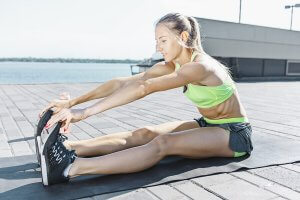
Not warming up your lower body before working out can cause discomfort, pain and even injuries. Leg stretches are a priority before hitting the gym or doing any sport.
Even if you practice sports at home, it’s important to have a stretching routine. The goal of those routines is to cover as many muscle groups as possible.
Fortunately, doing these leg stretches is fast, easy and only requires knowledge of a few basic positions. Ten minutes will be enough to ensure that you begin your workout with soft, warm and stretched muscles.
Let’s start with leg stretches for your quads
Starting with the easiest movements will give you the motivation to continue with the next activities.
Start by grabbing one of your ankles behind your legs and try to keep the balance while standing on the other leg. Wait for 10 seconds and repeat the same thing with the leg you were grabbing.
This base position will stretch the upper legs. Of course, it’s very important to perform it correctly. This means you’ll even have to stretch your foot, pointing the toes upwards.

For the second movement, you have to get down on your knees, with your legs open. Your feet should also be pointing outwards, with the sole facing up.
The movement of your torso is important; you should be leaning back. This part is the key to stretch the left and right leg quad properly.
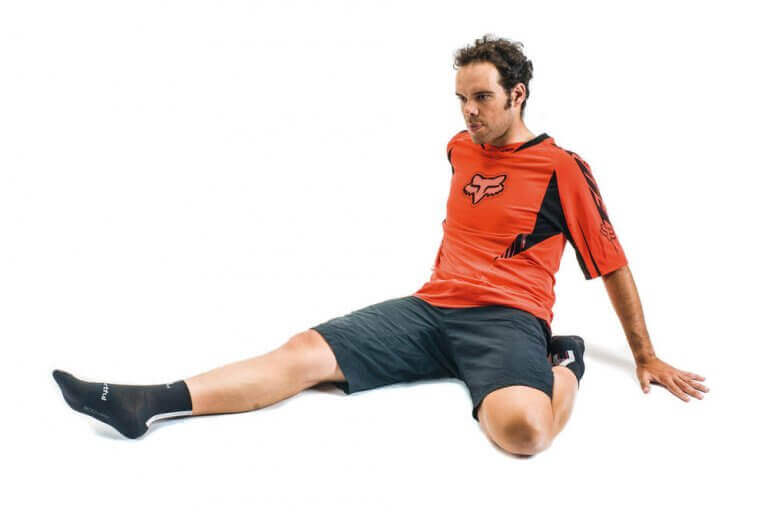
Leg stretches for your hamstrings and adductors
To work on your hamstrings during a warm-up routine, you need to sit down on the floor. The idea is to stretch one foot while you try to touch the tips of your toes with your hands. This way, you’ll stretch your torso in the direction of the leg you have outstretched. Repeat the same process with your other leg.
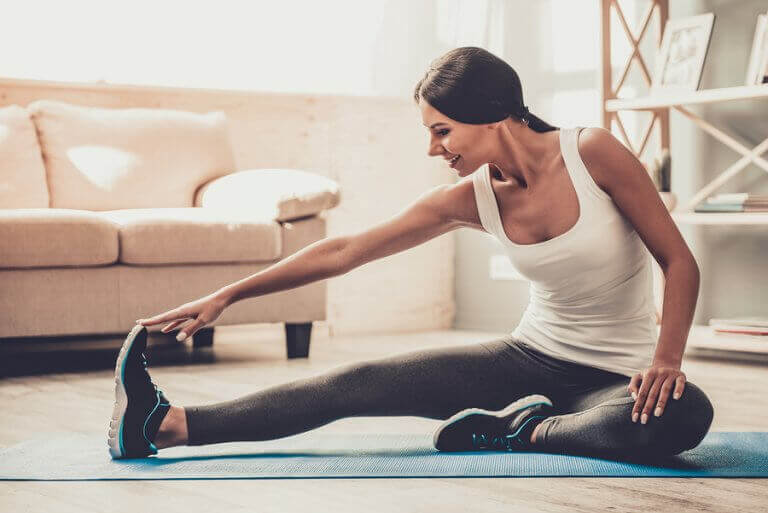
For the next part, stay down on the floor. Open up your legs in a ‘V’ shape and move your torso forward as far as you can. With your arms, emphasize the stretch as much as you can and touch the floor with your fingers.
These exercises are more than enough to warm up and stretch your adductor muscles specifically. In both movements, the important thing is to stretch as far as possible and hold that position for a few seconds.
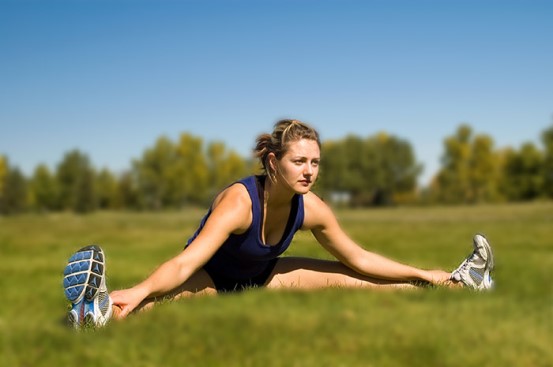
Calf extension
The best way to stretch your calves is by lifting them and then letting them fall back down by their own weight. To do this, look for a wall or surface that is at least at hip-level. The important thing is that the bottom of your leg is securely in place.
This position helps the muscle to stretch on its own while we flex the leg. Gravity will be in charge of applying pressure. If the angle of the wall allows it, the best thing to do is stretch your torso forward.
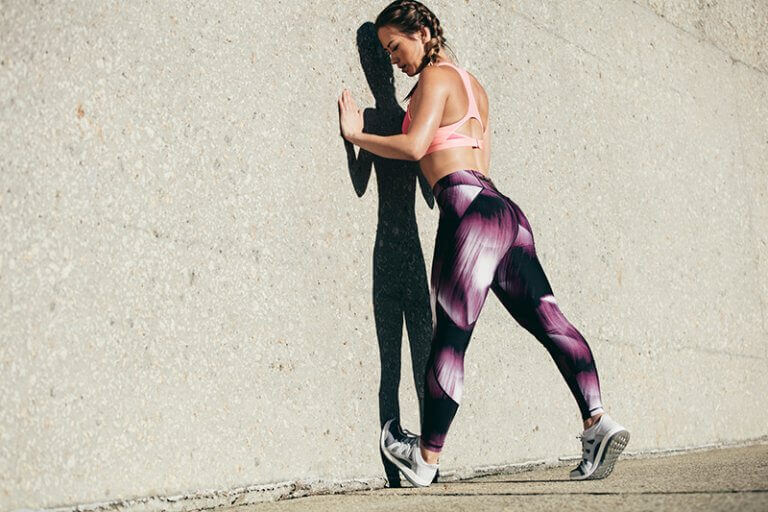
With these postures, you’ll pretty much cover all of your muscles and joints. However, if you want a more thorough stretching routine, there are a couple more leg stretches that you can add.
Leg stretches: femoral bicep and iliotibial band
The next posture is quite complex, therefore, we do not recommend it for people with spine problems. To stretch the iliotibial band, cross your legs while keeping the back leg stiff and the front leg flexed. Then, go down and hold the ankles with your hands. Keep that posture for a few seconds.
After that, repeat the same steps but switch legs. It’s important to mention that this movement can help prevent knee injuries. Among all the different stretches, this is one of the most unknown.
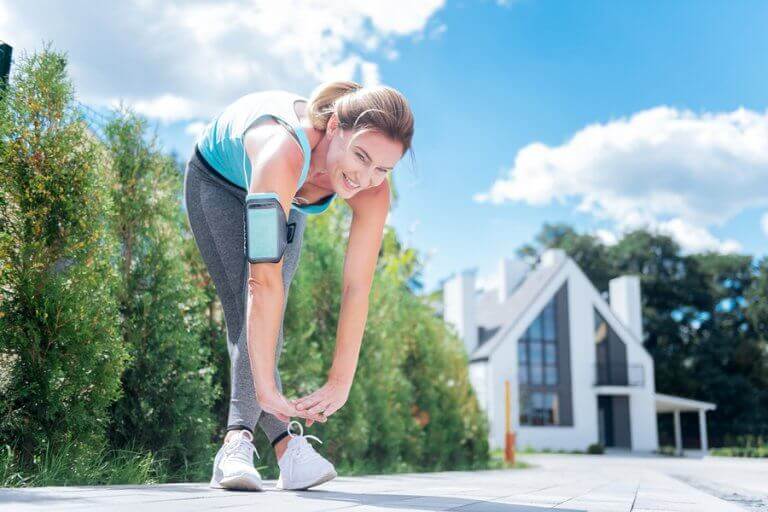
To complete the routine, you can work on each femoral bicep with specialized and isolated movements. You’ll need a band or other tool to add resistance to the extension. You can even use a towel for this.
Basically, the exercise consists of lying down on the floor and lifting one of your legs completely. Then, grab the band with both of your hands and place it over the sole of your foot. Now, use your hands to pull on the band and apply a bit of pressure on your leg. A few seconds will be more than enough.
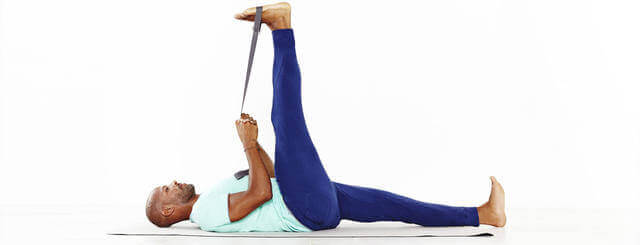
Now you’re ready to work out, play soccer, basketball or run any race. The risk of twinges, sprains and muscle pain will lower considerably if you complete this routine. Even though it may not seem so, leg stretches are very useful and can help to prevent many physical problems.
Not warming up your lower body before working out can cause discomfort, pain and even injuries. Leg stretches are a priority before hitting the gym or doing any sport.
Even if you practice sports at home, it’s important to have a stretching routine. The goal of those routines is to cover as many muscle groups as possible.
Fortunately, doing these leg stretches is fast, easy and only requires knowledge of a few basic positions. Ten minutes will be enough to ensure that you begin your workout with soft, warm and stretched muscles.
Let’s start with leg stretches for your quads
Starting with the easiest movements will give you the motivation to continue with the next activities.
Start by grabbing one of your ankles behind your legs and try to keep the balance while standing on the other leg. Wait for 10 seconds and repeat the same thing with the leg you were grabbing.
This base position will stretch the upper legs. Of course, it’s very important to perform it correctly. This means you’ll even have to stretch your foot, pointing the toes upwards.

For the second movement, you have to get down on your knees, with your legs open. Your feet should also be pointing outwards, with the sole facing up.
The movement of your torso is important; you should be leaning back. This part is the key to stretch the left and right leg quad properly.

Leg stretches for your hamstrings and adductors
To work on your hamstrings during a warm-up routine, you need to sit down on the floor. The idea is to stretch one foot while you try to touch the tips of your toes with your hands. This way, you’ll stretch your torso in the direction of the leg you have outstretched. Repeat the same process with your other leg.

For the next part, stay down on the floor. Open up your legs in a ‘V’ shape and move your torso forward as far as you can. With your arms, emphasize the stretch as much as you can and touch the floor with your fingers.
These exercises are more than enough to warm up and stretch your adductor muscles specifically. In both movements, the important thing is to stretch as far as possible and hold that position for a few seconds.

Calf extension
The best way to stretch your calves is by lifting them and then letting them fall back down by their own weight. To do this, look for a wall or surface that is at least at hip-level. The important thing is that the bottom of your leg is securely in place.
This position helps the muscle to stretch on its own while we flex the leg. Gravity will be in charge of applying pressure. If the angle of the wall allows it, the best thing to do is stretch your torso forward.

With these postures, you’ll pretty much cover all of your muscles and joints. However, if you want a more thorough stretching routine, there are a couple more leg stretches that you can add.
Leg stretches: femoral bicep and iliotibial band
The next posture is quite complex, therefore, we do not recommend it for people with spine problems. To stretch the iliotibial band, cross your legs while keeping the back leg stiff and the front leg flexed. Then, go down and hold the ankles with your hands. Keep that posture for a few seconds.
After that, repeat the same steps but switch legs. It’s important to mention that this movement can help prevent knee injuries. Among all the different stretches, this is one of the most unknown.

To complete the routine, you can work on each femoral bicep with specialized and isolated movements. You’ll need a band or other tool to add resistance to the extension. You can even use a towel for this.
Basically, the exercise consists of lying down on the floor and lifting one of your legs completely. Then, grab the band with both of your hands and place it over the sole of your foot. Now, use your hands to pull on the band and apply a bit of pressure on your leg. A few seconds will be more than enough.

Now you’re ready to work out, play soccer, basketball or run any race. The risk of twinges, sprains and muscle pain will lower considerably if you complete this routine. Even though it may not seem so, leg stretches are very useful and can help to prevent many physical problems.
All cited sources were thoroughly reviewed by our team to ensure their quality, reliability, currency, and validity. The bibliography of this article was considered reliable and of academic or scientific accuracy.
- Julio Gutiérrez Muñoz. Ejercicios de estiramiento. Extraído de: http://www.sld.cu/galerias/pdf/sitios/rehabilitacion-ejer/estiramientos_1.pdf
- Estiramientos de miembros inferiores. Fisioterapia Althea. Extraído de: http://www.fisioterapiaathenea.com/recursos/ESTIRAMIENTOS%20DE%20MIEMBROS%20INFERIORES.pdf
This text is provided for informational purposes only and does not replace consultation with a professional. If in doubt, consult your specialist.








